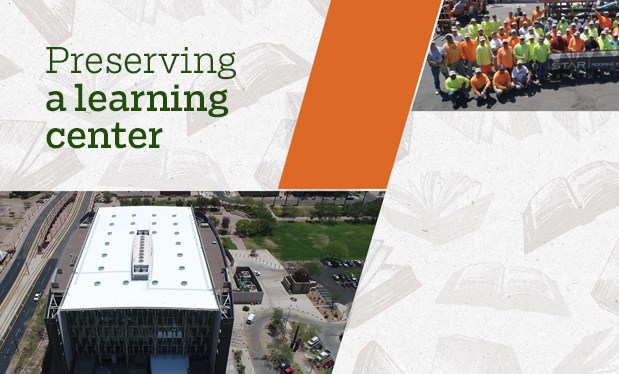Based on calls being received by NRCA's Technical Services Section, there appears to be confusion in the roofing industry regarding FM 4435, "Approval Standard for Edge Systems Used with Low Slope Roofing Systems," FM Approvals' criteria for metal edge testing. Perhaps the confusion lies with the FM 4435 designation also being included in the title of the U.S. national consensus standard for metal edge flashings. Also, there appears to be some lack of understanding by specifiers regarding how they should properly implement FM 4435. Following is a brief explanation to provide some clarity.
ANSI/SPRI/FM 4435/ES-1
The U.S. national consensus standard for testing the wind resistances of metal edge flashings (except gutters) is ANSI/SPRI/FM 4435/ES-1, "Test Standard for Edge Systems Used with Low Slope Roofing Systems." The most current edition of the standard was published in 2017 and is designated ANSI/SPRI/FM 4435/ES-1-2017.
The standard's previous edition, which was published in 2011 and is designated ANSI/SPRI/FM 4435/ES-1-2011, is referenced in the International Building Code,® 2015 Edition (IBC® 2015) and IBC 2018.
Earlier editions of the standard were designated as ANSI/SPRI ES-1 (not including the "FM 4435" designation) and were referenced in other IBC editions since the 2003 edition.
FM 4435
FM 4435 is FM Approvals' in-house method for testing and evaluating metal edge flashings. The current edition of FM 4435 was published in June 2013 and had an effective date of Dec. 31, 2014. The previous edition of FM 4435 was dated August 2004.
Unlike ANSI/SPRI/FM 4435/ES-1, FM 4435 is not a recognized consensus standard and not referenced in the IBC.
FM 4435 is referenced in FM Global's Property Loss Prevention Data Sheet 1-49, "Perimeter Flashings" (FM 1-49), as a recommendation for perimeter flashings on FM Global-insured buildings. FM 1-49 also references the construction details contained in The NRCA Roofing Manual: Architectural Metal Flashing and Condensation and Air Leakage Control. FM 4435 has separate guidelines for testing; reporting of test results; quality-assurance procedures for manufacturing; and product or packaging making.
FM 4435 uses ANSI/SPRI/FM 4435/ES-1-2011's RE-1, RE-2 and RE-3 test methods as the basis for its testing. However, instead of reporting test results as resistance pressures in pounds per square foot, FM 4435's results are reported using FM Approvals' classification designations (1-60, 1-90, 1-120, etc.). FM 4435's Table 1 is used to convert ANSI/SPRI/FM 4435/ES-1-2011's RE-1 test results into classification designations. FM 4435's Table 2 is used to convert ANSI/SPRI/FM 4435/ES-1-2011's RE-2 and RE-3 test results into classification designations. It appears FM 4435's tables include some mathematical rounding and the addition of a safety factor for determining classification values.
FM 4435's manufacturing quality-assurance procedures criteria requires fabricators to establish and maintain a quality-assurance program with specific process controls. FM Approvals also conducts periodic—usually one per year—surveillance audits to verify the established quality-assurance program is being carried out.
FM 4435's marking criteria requires fabricators to apply an FM Approvals' mark on the product or its packaging.
Specifying FM 4435
To properly specify FM 4435-compliant metal edge for FM Global-insured projects, designers need to identify the FM Approvals' test criteria and specific FM Approvals' classification desired for the specific project.
FM Approvals' metal edge testing is best identified by using the designation "FM 4435" or "FM Approvals' approved metal edge flashing." FM Approvals' classifications should be designed as "1-60," "1-75," "1-90," etc. as required for the specific project.
Designers can use the Rating Calculator contained in FM Approval's RoofNav application, www.roofnav.com, to help determine project-specific classifications.
Information about specific metal edge flashings currently complying with FM 4435 is accessible using RoofNav's Product Search function.
Closing thoughts
FM 4435 is FM Approvals' proprietary adaption for the metal edge test methods contained in ANSI/SPRI/FM 4435/ES-1-2011. FM 4435 also includes some enhancements, such as establishment of a manufacturing quality-assurance procedure and periodic surveillance audits, which may be desirable to some designers, specifiers and building owners.
The concept of implementing ANSI/SPRI/FM 4435/ES-1-2011 testing with such enhancements is not unique; NRCA has been doing so with its shop-fabricated metal edge testing and certification programs since 2001—before ANSI/SPRI ES-1 testing was a building code requirement.
NRCA's certification programs can be considered even more stringent than FM 4435. For example, in NRCA's UL and Intertek certification programs, its manufacturing quality-assurance procedures are consistent among each of the more than 300 participating fabricators. Also, in the UL certification program, for example, factory audits are conducted by UL four times per year at each fabrication location.
Additional information about NRCA's shop-fabricated metal edge testing and certification programs is available in the Technical section of NRCA's website.
Mark S. Graham is NRCA's vice
president of technical services.
@MarkGrahamNRCA
This column is part of Research + Tech. Click here to read additional stories from this section.



